Land Use Dynamics of Drove Roads: The Case of Tratturo Castel di Sangro-Lucera (Molise, Italy)
Abstract
:1. Introduction
1.1. Past and Present Transhumance in Italy
1.2. The Drove Roads in the Molise Region
1.3. Research Aims
2. Materials and Methods
2.1. Study Area
2.2. Materials
- 4 historical maps: Capecelatro’s Atlas maps (1651), Map of southern Italy (1875), Bonamici’s reinstatement maps (1875–1884), The Map of Italy (1957),
- maps of land and property: the Land Registry maps (1947–2005 and 2016),
- 2 land cover maps derived using photointerpration of aerial photograms of the GAI flight (1954), and photointerpration of ESRI aerial images (2014),
- 3 archival sources: Capecelatro’s Atlas, Bonamici’s reinstatement, Italian Land Registry.
2.3. The Reconstruction of the Tratturo’s Limits
2.4. The Overlay between the Two Reinstatements
2.5. Land Cover Maps of 1954 and 2014
3. Results
3.1. The Dynamics of Squatting on the Tratturo Castel Di Sangro-Lucera
3.2. The Conservation Hot Spot
4. Discussion
5. Conclusions
Supplementary Materials
Acknowledgments
Author Contributions
Conflicts of Interest
Appendix A
A.1. Data Source Details
A.1.1. Capecelatro’s Atlas
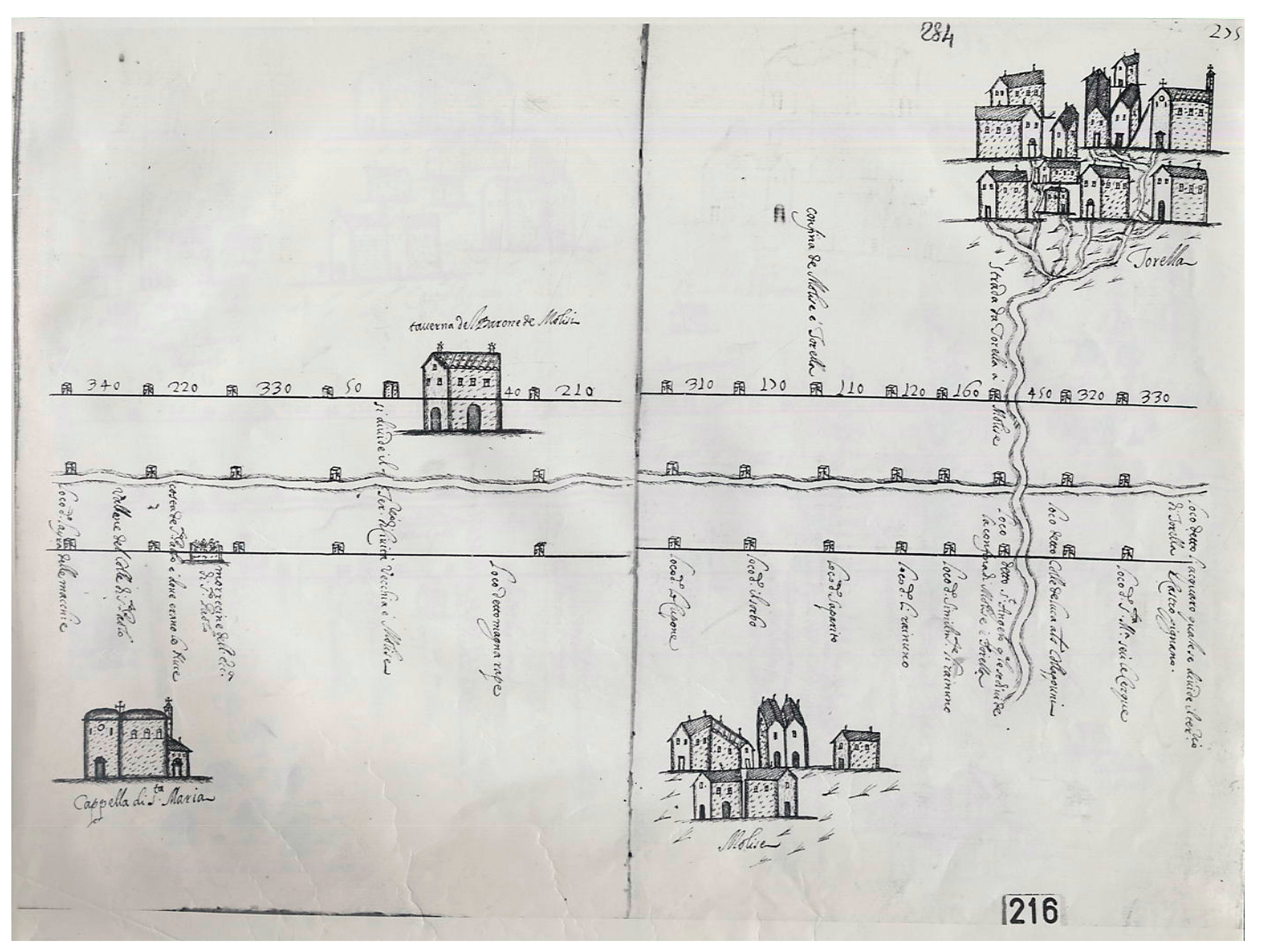
A.1.2. Map of Southern Italy (ITMI)

A.1.3. Eduardo Bonamici’s Reinstatement (BR)
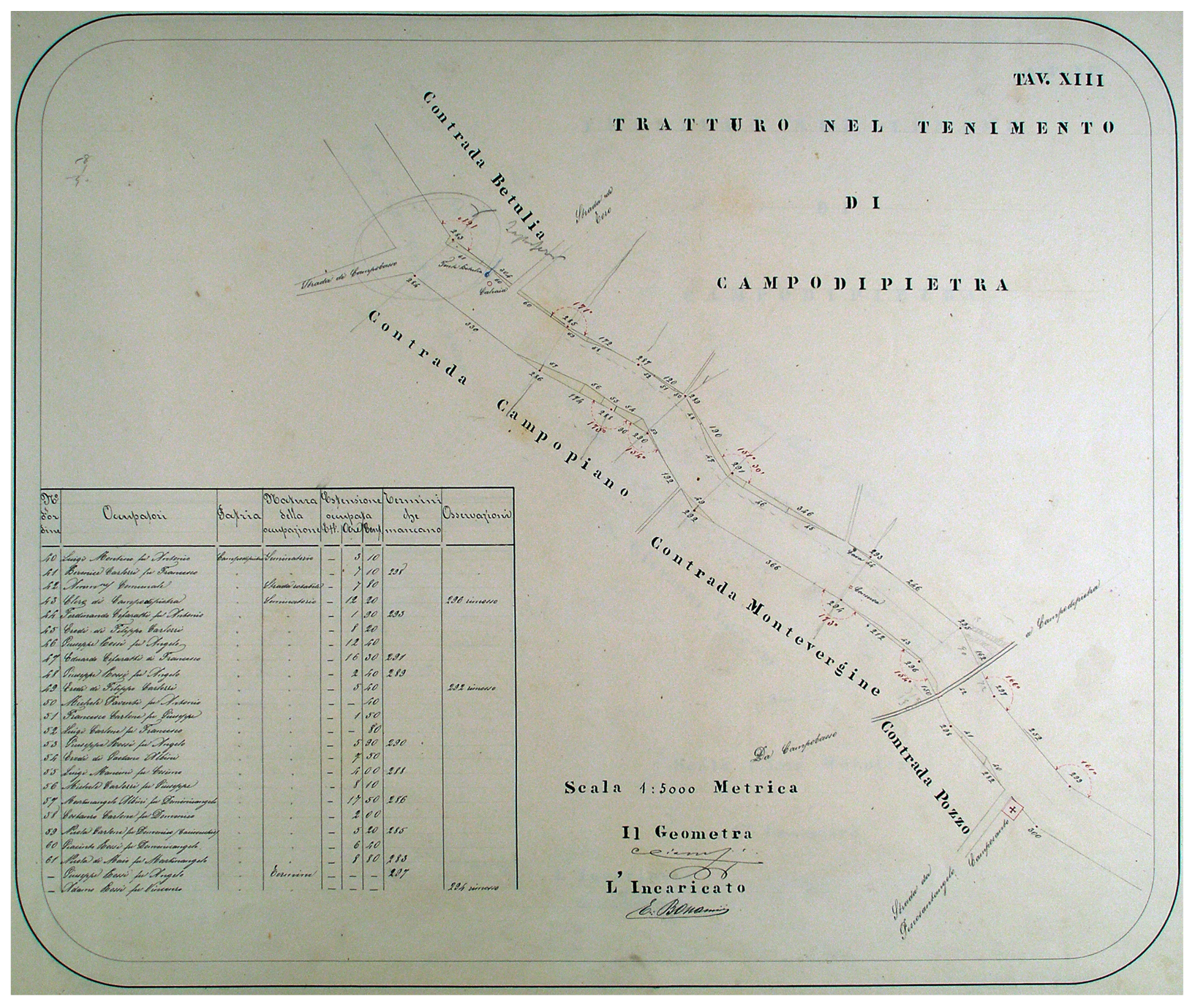
A.1.4. The GAI Flight (GAI)
A.1.5. The Map of Italy (IGMI)
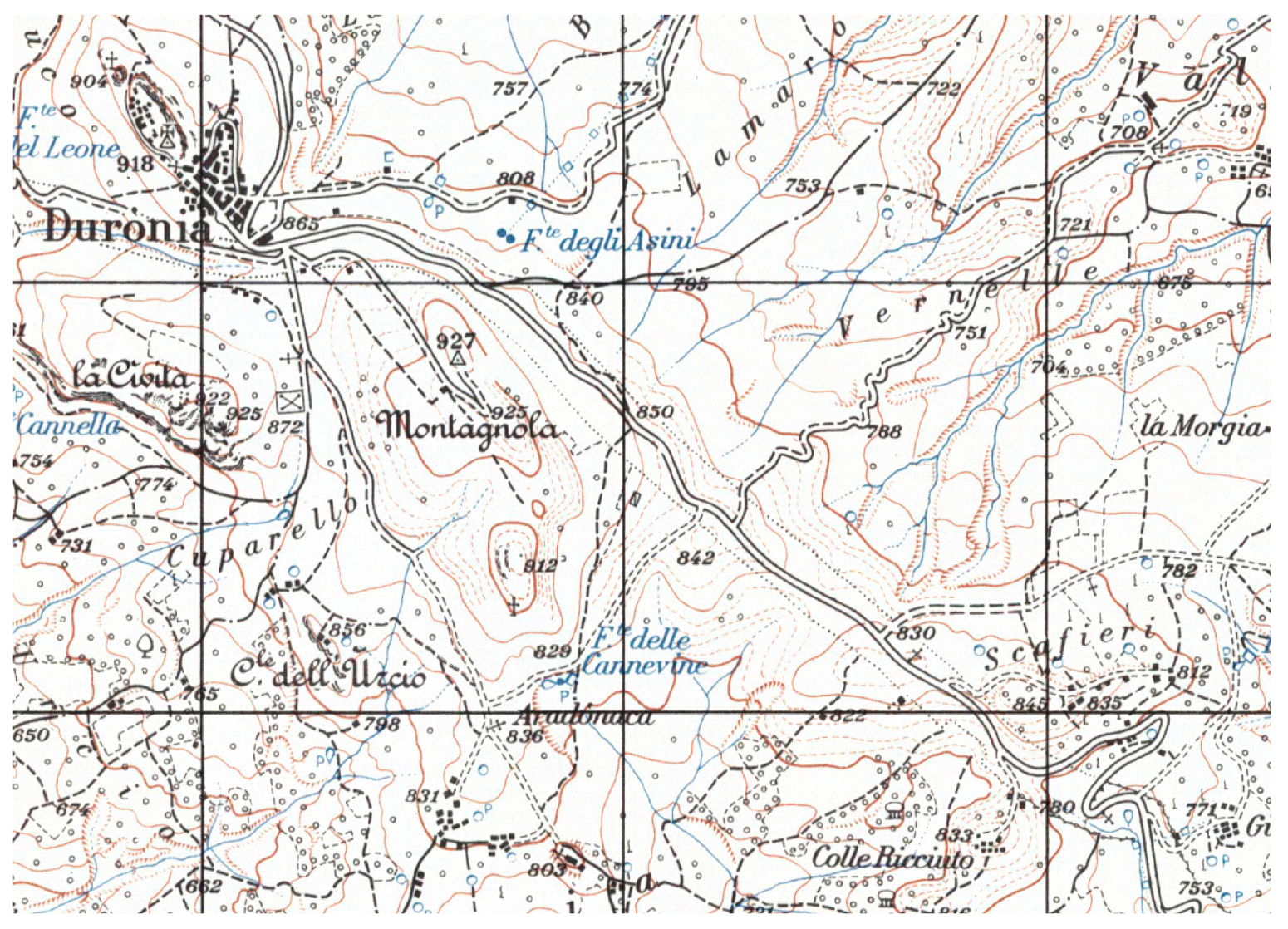
A.1.6. The Land Registry (1947–2005)
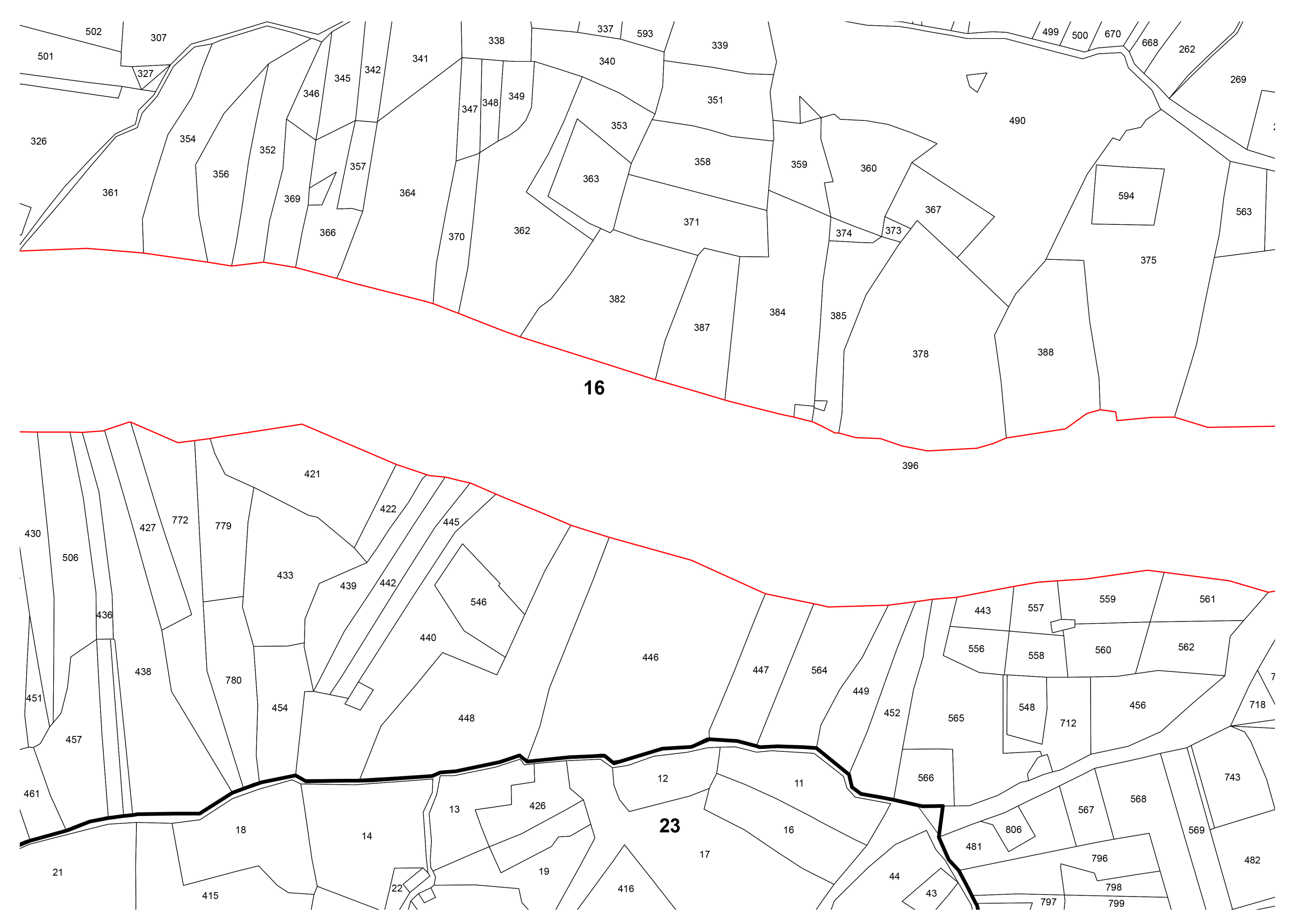
A.1.7. The Aerial Images (2012–2014)
References
- Bower, J. The Pastoral Neolithic of East Africa. J. World Prehist. 1991, 5, 49–82. [Google Scholar] [CrossRef]
- Dong, S.; Kassam, K.-A.S.; Tourrand, J.F.; Boone, R.B. (Eds.) Building Resilience of Human-Natural Systems of Pastoralism in the Developing World: Interdisciplinary Perspectives; Springer International Publishing: Cham, Switzerland, 2016. [Google Scholar] [CrossRef]
- Gόmez-Ibáñez, D.A. Energy, economics, and the decline of transhumance. Geogr. Rev. 1977, 67, 284–298. Available online: http://www.jstor.org/stable/213723 (accessed on 11 November 2016). [CrossRef]
- Morgado, P.; Rocha, L. Caminhos antigos do Concelho de Monforte. Sci. Antiquitatis 2017, 1, 287–308. Available online: http://www.scientiaantiquitatis.uevora.pt/index.php/SA/article/view/93 (accessed on 15 December 2017).
- Bunce, R.G.H.; Pérez-Soba, M.; Jongman, R.H.G.; Gómez Sal, A.; Herzog, F.; Austad, I. Transhumance and Biodiversity in European Mountains; Report of the EU-FP5 Project TRANSHUMOUNT (EVK2-CT-2002-80017); IALE Publication Series; IALE Publication: Wageningen, The Netherlands, 2004. [Google Scholar]
- Oteros-Rozas, E.; Gonzalez, J.A.; Martìn-Lòpez, B.; Lòpez, C.A.; Zorrilla-Miras, P.; Montes, C. Evaluating ecosystem services in transhumance cultural landscapes: An interdisciplinary and participatory framework. GAIA Ecol. Perspect. Sci. Soc. 2012, 21, 185–193. [Google Scholar]
- Papachristou, T.G. Greece’s grazing/forage resources for livestock production. In Ecosystem Services and Socio-Economic Benefits of Mediterranean Grasslands, Option Méditerranéennes 114; Kyriazopoulos, A., Lόpez-Francos, A., Porqueddu, C., Sklavou, P., Eds.; CHIEAM: Zaragoza, Spain, 2016; pp. 29–42. [Google Scholar]
- Francioni, M.; Toderi, M.; Lai, R.; Trozzo, L.; Foresi, L.; Sciarra, F.; Avanzolini, P.; Sedić, E.; Budimir, K.; Santilocchi, R.; D’Ottavio, P. Does transhumant sheep system provide ecosystem services for climate change adaptation in Mediterranean environment? In Ecosystem Services and Socio-economic Benefits of Mediterranean Grasslands, Option Méditerranéennes 114; Kyriazopoulos, A., Lόpez-Francos, A., Porqueddu, C., Sklavou, P., Eds.; CHIEAM: Zaragoza, Spain, 2016; pp. 103–106. [Google Scholar]
- Bunce, R.G.H.; De Aranzabal, I.; Schmitz, M.F.; Pineda, F.D. A Review of the Role of Drove Roads (Cañadas) as Ecological Corridors; Alterra-Rapport 1428; Alterra: Wageningen, The Netherlands, 2006. [Google Scholar]
- Manzano-Baena, P.; Casas, R. Past, present and future of transhumance in Spain: Nomadism in a developed country. Pastoralism 2010, 1, 172–190. [Google Scholar] [CrossRef]
- Biber, J.P. Transhumance in France. Pastoralism 2010, 1, 91–98. [Google Scholar] [CrossRef]
- Luick, R. Transhumance in Germany.Report to European Forum on Nature Conservation and Pastoralism; European Forum on Nature Conservation and Pastoralism (EFNCP) and University of Applied Sciences Rottenburg/Fachhochschule Rottengurg, Schadenweilerhof: Rottenburg, Germany, 2008; Available online: http://www.efncp.org/download/Swabian_Alb_F_F_Download.pdf (accessed on 15 November 2016).
- Huband, S.; McCracken, D.I.; Mertens, A. Long and short-distance transhumant pastoralism in Romania: Past and present drivers of change. Pastoralism 2010, 1, 55–71. [Google Scholar] [CrossRef]
- Matley, I.M. Transhumance in Bosnia and Herzegovina. Geogr. Rev. 1968, 58, 231–261. [Google Scholar] [CrossRef]
- Hadjigeorgiou, I. Past, present and future of pastoralism in Greece. Pastor. Res. Policy Pract. 2011, 1. [Google Scholar] [CrossRef]
- Peattie, R. M. Mountain Geography—A Critique and Field Study; Harvard University Press: Cambridge, MA, USA, 1936. [Google Scholar]
- Graziani, M.; Avram, M. Il “genius loci” del “tratturo”. Recupero del retaggio della transumanza nel Parco Nazionale d’Abruzzo, Lazio e Molise (Italia). ETNICEX Revista de Estudios Etnograficos 2011, 2, 77–92. [Google Scholar]
- Takola, E.; Sidiropoulou, A.; Karatassiou, M. The impact of transhumance abandonment on land use changes in Mount Pindos (Greece). In Ecosystem Services and Socio-Economic Benefits of Mediterranean Grasslands, Option Méditerranéennes 114; Kyriazopoulos, A., Lόpez-Francos, A., Porqueddu, C., Sklavou, P., Eds.; CHIEAM: Zaragoza, Spain, 2016; pp. 143–146. [Google Scholar]
- United Nations Educational, Scientific and Cultural Organization (UNESCO); World Heritage Centre. The Causses and the Cévennes, Mediterranean Agro-Pastoral Cultural Landscape 2011. Available online: http://whc.unesco.org/en/list/1153 (accessed on 2 October 2017).
- United Nations Educational, Scientific and Cultural Organization (UNESCO); World Heritage Centre. Hallstatt-Dachstein/Salzkammergut Cultural Landscape 1997. Available online: http://whc.unesco.org/en/list/806 (accessed on 2 October 2017).
- United Nations Educational, Scientific and Cultural Organization (UNESCO); World Heritage Centre. Pyrénées—Mont Perdu 1997. Available online: http://whc.unesco.org/en/list/773 (accessed on 2 October 2017).
- United Nations Educational, Scientific and Cultural Organization (UNESCO); World Heritage Centre. The Transhumance: The Royal Shepherd’s Track-Tentative list01/06/2006. Available online: http://whc.unesco.org/en/tentativelists/5005/ (accessed on 5 August 2016).
- United Nations Educational, Scientific and Cultural Organization (UNESCO); World Heritage Centre. Mesta Livestock Trails-Tentative list24/07/2007. Available online: http://whc.unesco.org/en/tentativelists/5128/ (accessed on 6 October 2017).
- Ministerio de Educación, Cultura y Deporte. Real Decreto 385/2017, de 8 de Abril, por el que se Declara la Trashumanciacomo Manifestación Representativa del Patrimonio Cultural Inmaterial. Available online: https://www.boe.es/diario_boe/txt.php?id=BOE-A-2017-4009 (accessed on 2 October 2017).
- Pellicano, A.; Zarrilli, L. I toponimi della transumanza nell’Abruzzo aquilano tra retaggio storico e persistenze socio-culturali. In Toponomastica Italiana. L’eredità Storica e le Nuove Tendenze; Società Geografica Italiana: Rome, Italy, 2008; pp. 213–231. [Google Scholar]
- Bil, A. Transhumance place-names in Perthshire. Soc. Antiq. Scotl. 1992, 122, 383–402. [Google Scholar]
- Landi, F.; Calzolai, L. Transhumance routes in Tuscany: Cartography, place names, virtual landscaping. Rev. Hist. Geogr. Toponomast. 2015, 10, 99–124. [Google Scholar]
- Mallorquí, E.; Amigό, R.; Rabella, J.A.; Tort, J.; Roma, F. Toponímia, Paisatge i Cultura: Els Noms de lloc de la Lingüística, la Geografia y la Història; Documenta Universitaria Biblioteca D’història Rural: Girona, Spain, 2015. [Google Scholar]
- Agnoletti, M. Paesaggi Rurali Storici: Per un Catalogo Nazionale; Laterza: Bari, Italy, 2011; pp. 420–422. [Google Scholar]
- Ley 3/1995, de 23 de Marzo. Agencia Estatal Boletín Oficial del Estado n. 71 de 24 marzo de 1995. Available online: https://www.boe.es/buscar/doc.php?id=BOE-A-1995-7241 (accessed on 20 October 2017).
- Ministerio de Agricultura, Alimentación y Medio Ambiente. Cuadernos de la Trashumancia, Vías Pecuarias. Available online: http://www.mapama.gob.es/es/desarrollo-rural/temas/politica-forestal/vias-pecuarias/rvp_cuadernos_trashumancia.aspx (accessed on 22 december 2017).
- Cameron, J.M.R.; Spooner, P.G. Origins of Travelling Stock Routes. 2. Early development, management, and the growing embrace of the law (1830–70s). Rangel. J. 2010, 32, 341–351. [Google Scholar]
- Spooner, P.G.; Firman, M. Yalmambirra Origins of Travelling Stock Routes. 1. Connections to Indigenous traditional pathways. Rangel. J. 2010, 32, 329–339. [Google Scholar] [CrossRef]
- Garcia Martí, P. La Mesta: Transumanza e Istituzioni in Castiglia dal XIII al XIX Secolo; Mediterranea Collana di Studi Storici 12; Edipuglia: Bari, Italy, 1998. [Google Scholar]
- Guenzi, A.; Rossi, R. Institutions, natural resources and economic growth in the modern age: The case of Dogana delle Pecore in the Kingdom of Naples (XV-XVIII Centuries). Rev. Econ. Inst. 2014, 5. [Google Scholar] [CrossRef]
- Grana, S. Istituzioni Delle Leggi Della Regia Dohana di Foggia; Stamperia Raimondi: Napoli, Italy, 1770. [Google Scholar]
- Russo, S. Il conflitto tra agricoltura e pastorizia transumante nella Dogana di Foggia in età moderna. Mélanges de l’École Française de Rome-Antiquité 2016, 128–132. Available online: http://mefra.revues.org/3451 (accessed on 7 October 2017).
- Marino, J.A. Le Economie Pastorali nel Regno di Napoli; Guida Editori: Napoli, Italy, 1992. [Google Scholar]
- Pelicano, A. Geografia e Storia dei Tratturi del Mezzogiorno: Ipotesi di Recupero Funzionale di una Risorsa Antica; Aracne: Roma, Italy, 2007. [Google Scholar]
- Di Cicco, P. La Cartografia Tratturale. In La Capitanata Rassegna di Vita e di Studi della Provincia di Foggia; Archivio di Stato di Foggia: Foggia, Italy, 1987; p. II. Available online: http://www.bibliotecaprovinciale.foggia.it/capitanata/1987/1987pdf_parte2/1987_pII_51-57_diCicco.pdf (accessed on 9 September 2016).
- Caliandro, L.P.; Loisi, R.V.; Dal Sasso, P. Historical road system and farmhouses in Apulia. J. Agric. Eng. 2013, 44, 441–447. [Google Scholar] [CrossRef]
- Molise Regional Law n. 9 of 11 April 1997 “Tutela, Valorizzazione e Gestione del Demanio Tratturi”. Bollettino Ufficiale n° 08 del 16/04/97; Regione Molise: Campobasso, Italy, 1997.
- Molise Regional Committee Resolution No. 633 of 29 November 2013. Available online: http://www2.regione.molise.it/web/grm/deliberegiuntaanni2010.nsf/0/0E92C364704D9EDEC1257C45003E30EF?OpenDocument (accessed on 15 September 2016).
- Attraverso il Molise, sui Regi Tratturi d’Italia. Available online: http://www.tratturocoast2coast.org/ (accessed on 26 May 2016).
- Meini, M.; Adducchio, D.; Ciliberti, D.; Di Felice, G. Landscape conservation and valorization by satellite imagery and historic maps: The case of Italian transhumance routes. Eur. J. Remote Sens. 2014, 47, 375–387. [Google Scholar] [CrossRef]
- Petrocelli, E. Itinerari Sulle vie Della Transumanza; Touring Editore: Milano, Italy, 2011; pp. 149–153. [Google Scholar]
- Liebetanz, G. Camminandosi, Tratturo Tratturo: Indagine Topografica Comparata sul Territorio del Tratturo Lucera-Casteldisangro al Seguito di un Gregge Virtuale Seguendo il filo d’Arianna dell’Atlante Capecelatro; IRESMO: Campobasso, Italy, 1999. [Google Scholar]
- European Environment Agency. CORINE Land Cover. Available online: https://www.eea.europa.eu/publications/COR0-landcover (accessed on 11 April 2016).
- Snedecor, G.W.; Cochran, W.G. Statistical Methods, 7th ed.; Iowa State Univ. Press: Ames, IA, USA, 1980. [Google Scholar]
- Cohen, J. A coefficient of agreement for nominal scales. Educ. Psychol. Meas. 1960, 20, 37–46. [Google Scholar] [CrossRef]
- De Martino, D. Lavoro Istorico Positivo sul Tavoliere di Puglia; Tipografia Simoniana: Napoli, Italy, 1857. [Google Scholar]
- Ortega Cruz, D.J.C. Deslinde de la Vía Pecuaria “Cañada Real Galiana o Cordel Segoviano” en el Tramo Comprendido Dentro del Término Municipal de Pulgar Incluida la Parte Caballera con Cuerva, en la Provincia de TOLEDO. Master’s Thesis, Universidad de Valladolid, Seville, Spain, 2014. [Google Scholar]
- Mangas Navas, J.M. Determinación y Recuperación de la red Nacional de vías Pecuarias. In Proceedings of the I Congreso Nacional de Vías Pecuarias, Madrid, Spain, 4–7 May 2005; pp. 169–174. [Google Scholar]
- Ortiz Borrego, I. Directrices, objetivos, instrumentalización y datos generales del plan de recuperación y ordenación de las vías pecuarias de la Comunidad autónoma de Andalucía. In Proceedings of the I Congreso Nacional de Vías Pecuarias, Madrid, Spain, 4–7 May 2005; pp. 237–244. [Google Scholar]
- Barriguete, F.M. Archivo de la Mesta: Tipologías documentales y posibilidades de investigación (XVI-XVIII). Cuadernos de Historia Moderna 1996, 17, 193–216. [Google Scholar]
- Lentini, P.E.; Fischer, J.; Gibbons, P.; Lindenmayer, D.B.; Martin, T.G. Australia’s Stock Route Network: 1. A review of its values and implications for future management. Ecol. Manag. Restor. 2011, 12, 119–127. [Google Scholar] [CrossRef]
- Ntassiou, Κ.; Doukas, I.D.; Papadopoulos, I. On the study, modernisation, support and promotion of transhumance, through a dedicated web-GIS. IJSAMI 2016, 2, 193–205. [Google Scholar] [CrossRef]
- National Library of Australia. Map of New South Wales Showing Stock Routes, Tanks, Wells, and Trucking Stations, 1888. Available online: https://nla.gov.au/nla.obj-232204514/view (accessed on 20 December 2017).
- Plan of Stock Route Hughenden to Cloncurry, Queensland, 1899. Available online: https://nla.gov.au/nla.obj-231770786/view (accessed on 20 December 2017).
- Ministerio de Agricultura y Pesca, Alimentación y Medio Ambiente. Información Cartográfica de las vías Pecuarias por Provincias. Available online: http://www.mapama.gob.es/es/desarrollo-rural/temas/politica-forestal/vias-pecuarias/rvp_descargas.aspx (accessed on 22 December 2017).
- Cantile, A. Lineamenti di Storia Della Cartografia Italiana. Volume Secondo: Dal Seicento al Novecento; GEOWEB: Rome, Italy, 2013. [Google Scholar]
- Planetek Italia S.r.l. L’ortorettifica di Fotogrammi Storici Privi di Certificati di Calibrazione con ERDAS LPS: Il volo GAI. Available online: http://www.planetek.it/sites/default/files/LPS_voloGAI_casehistory_IUAV_Bologna_0.pdf (accessed on 5 May 2016).
- Portale Cartografico Regionale. Available online: http://servizi.geo.regione.molise.it/arcgis/services/Catasto/MapServer/WMSServer (accessed on 11 April 2016).
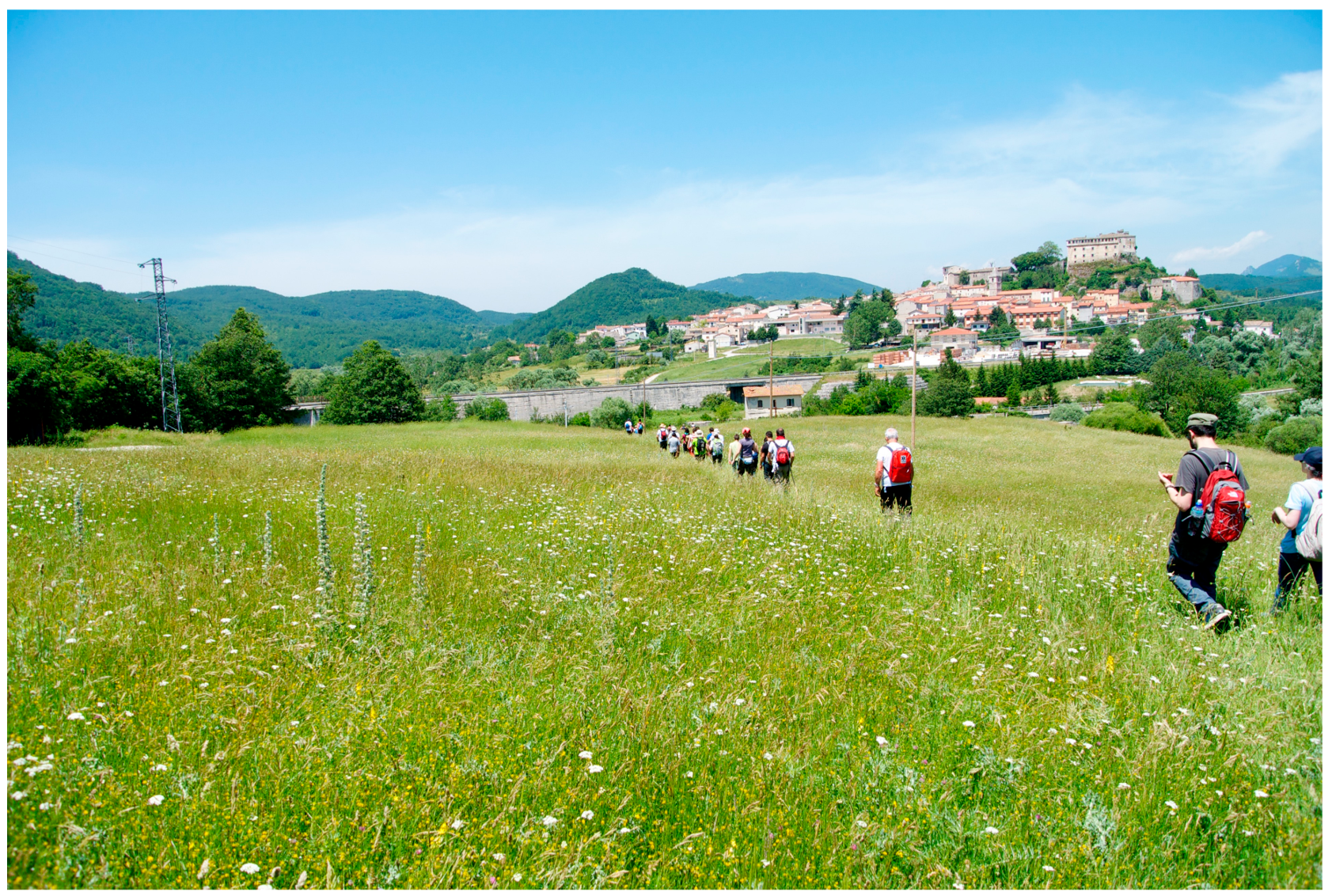
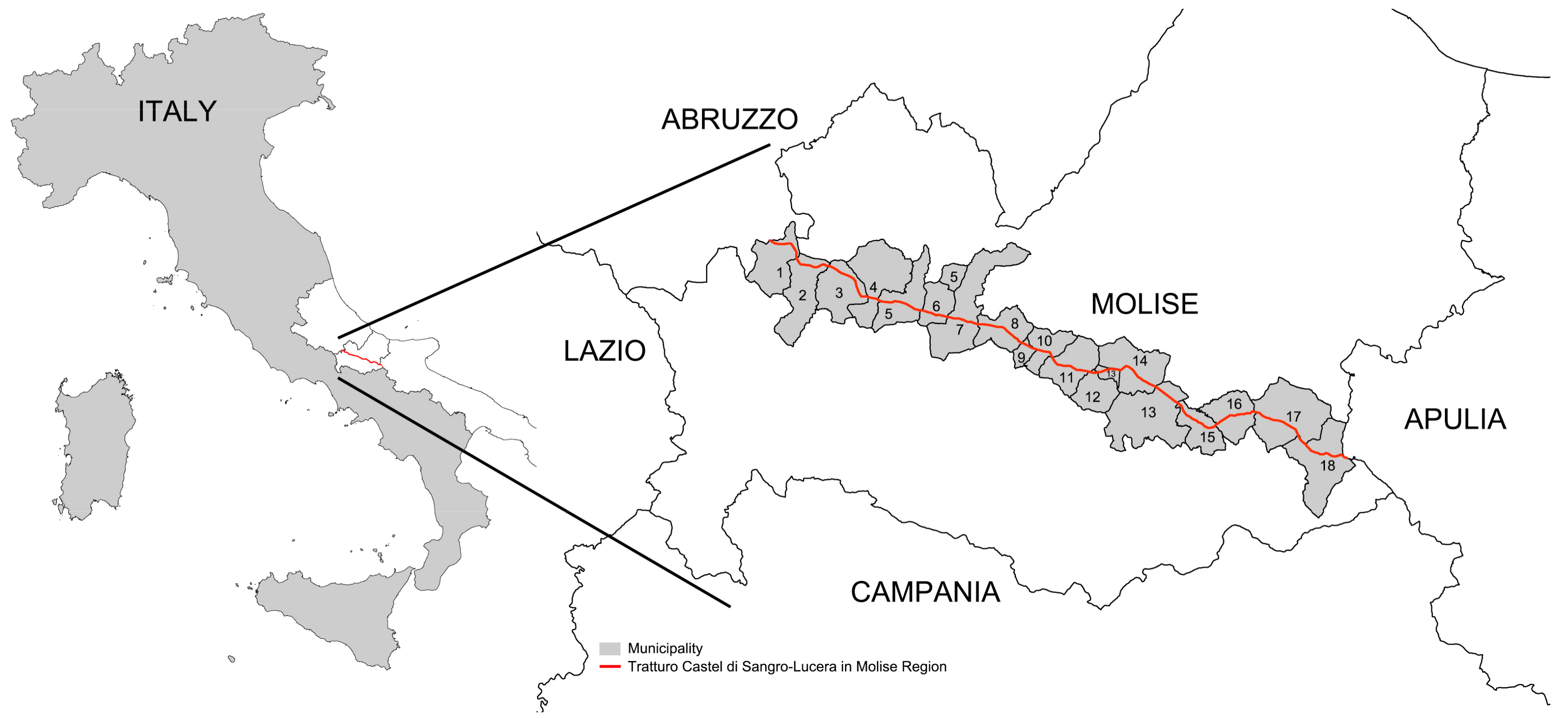
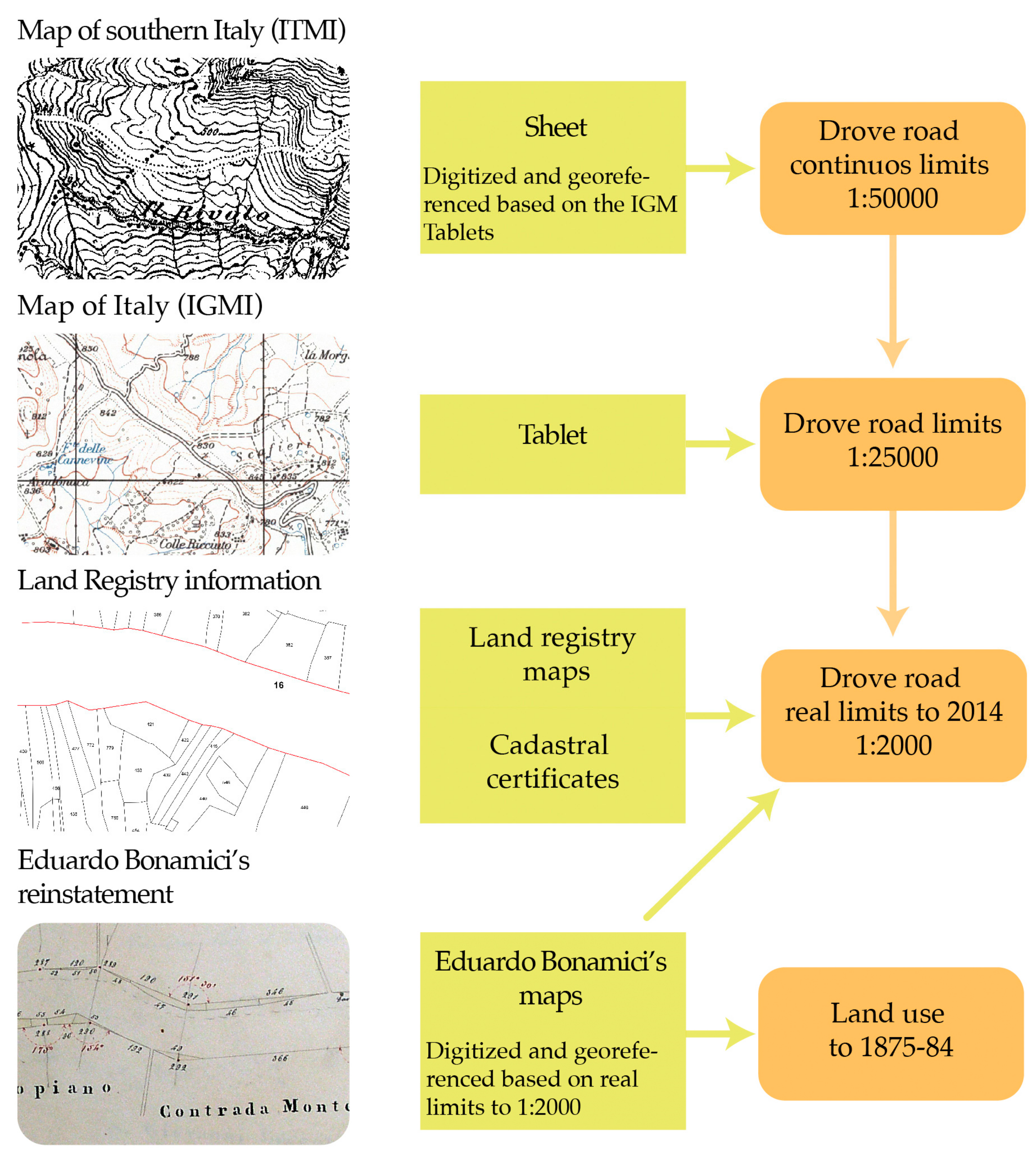
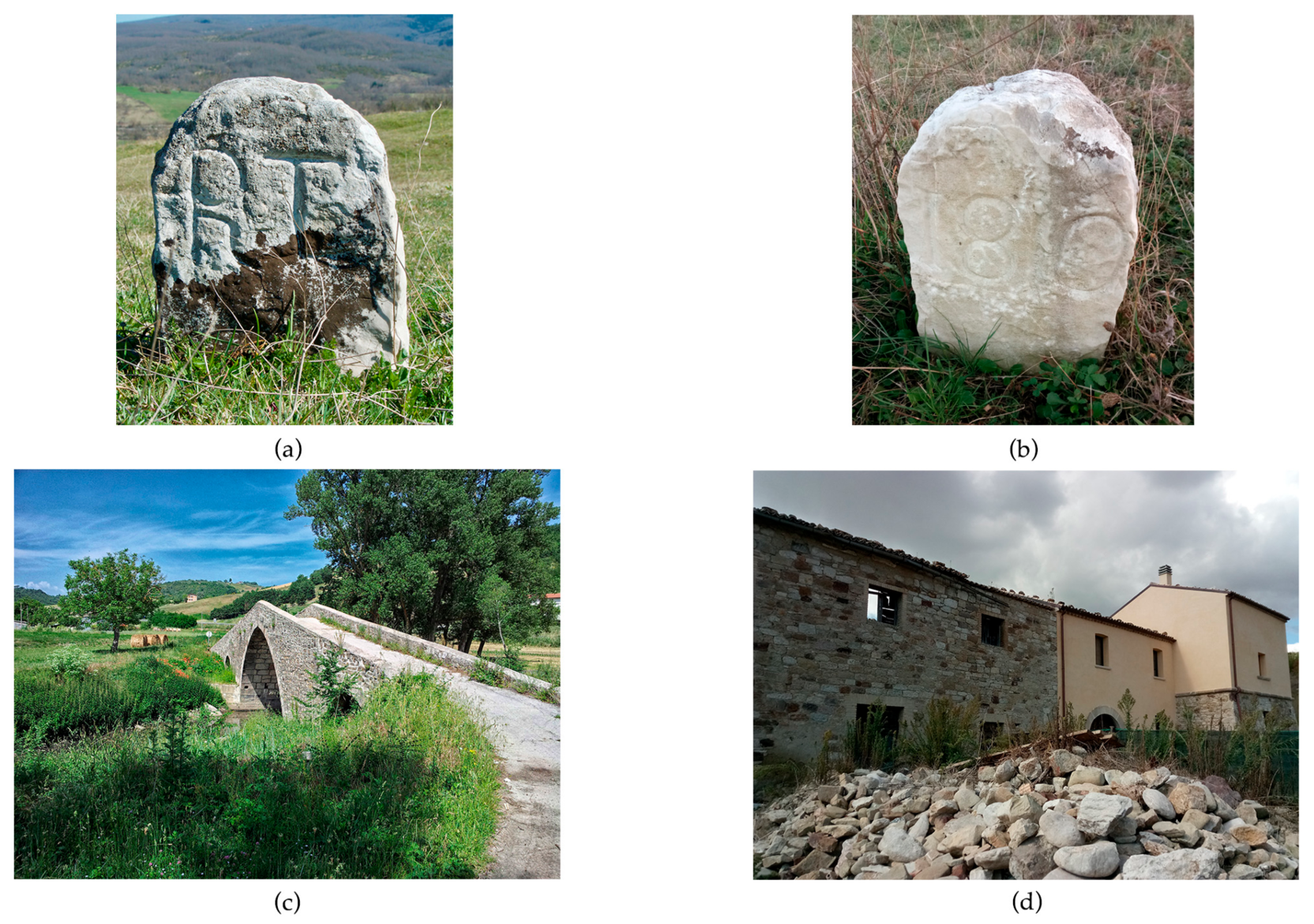
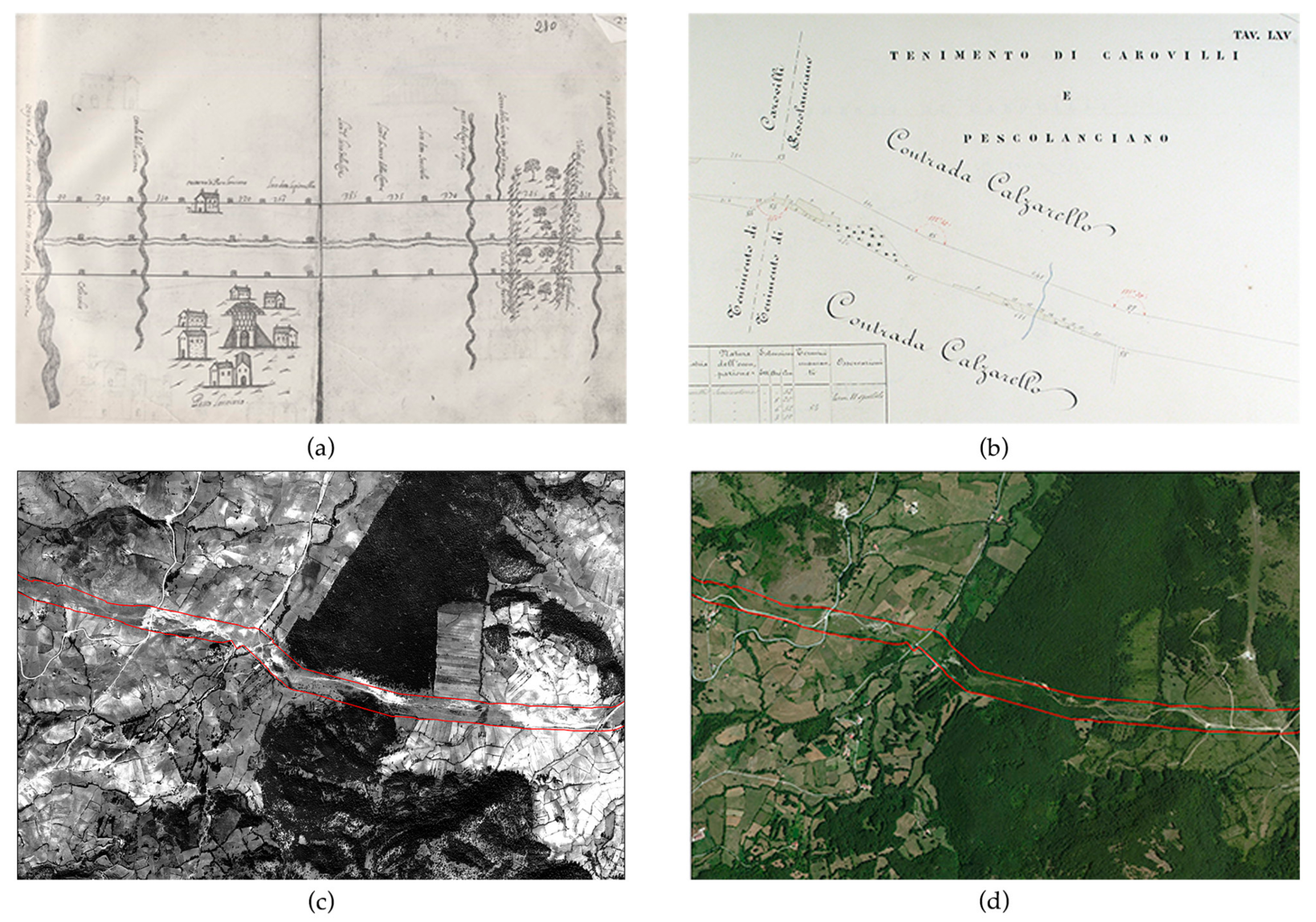
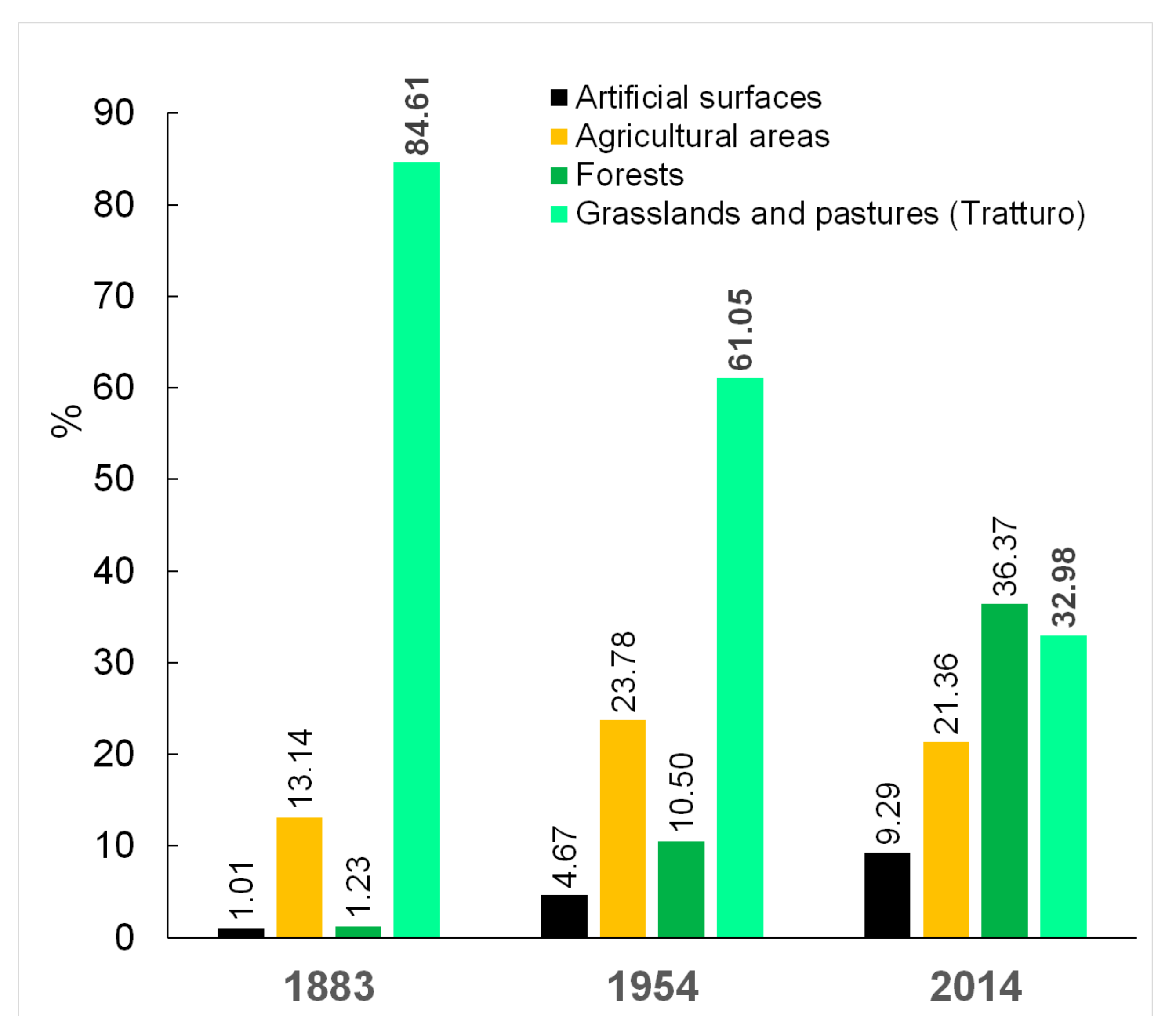
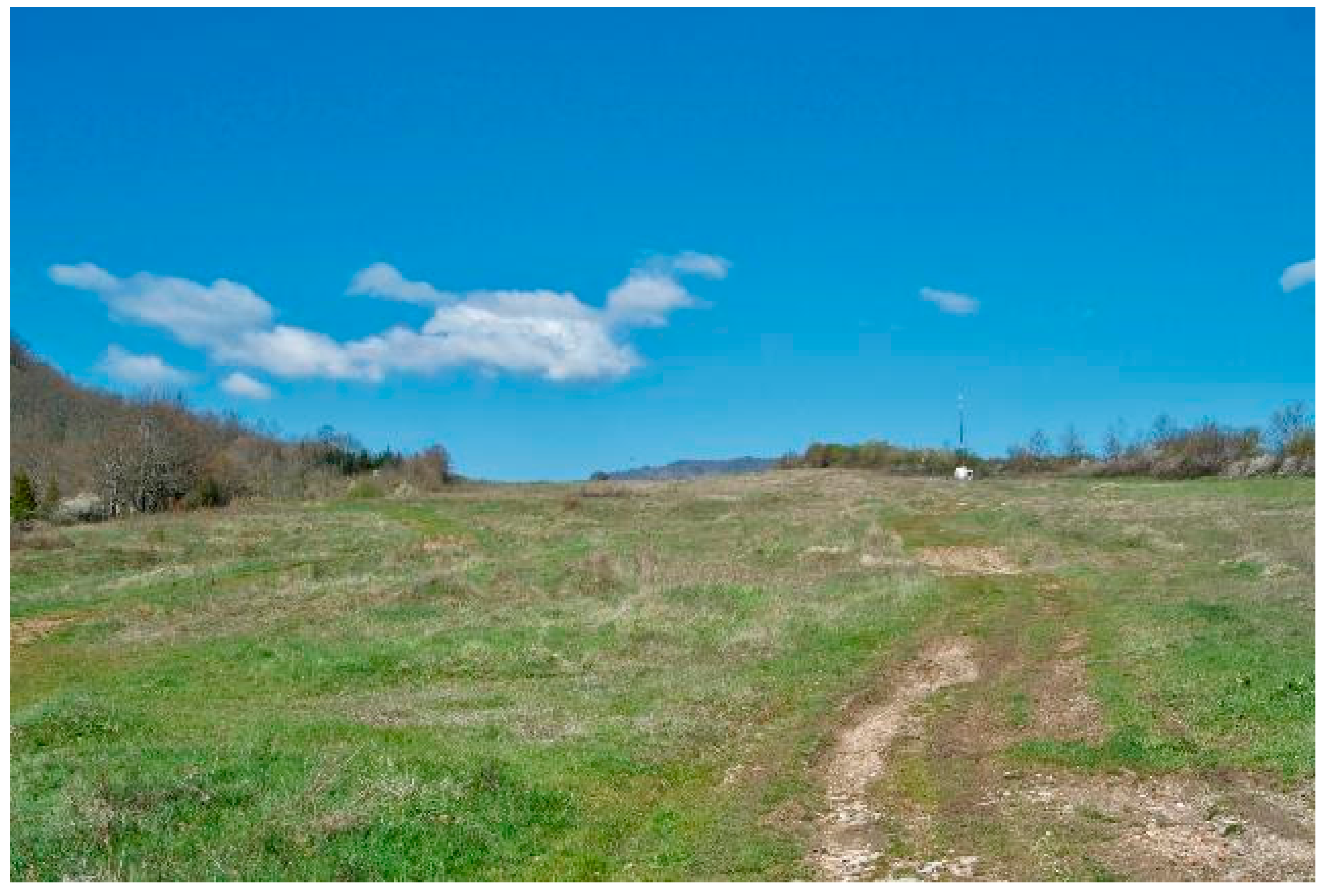
| N. | Municipality | Average Altitude (m a.s.l.) | Altitude Zones Classification | Tratturo Surface: Hectares (%) | Average Altitude (m a.s.l.) of the Tratturo Surface |
|---|---|---|---|---|---|
| 1 | Rionero Sannitico | 930 | Highland | 47.06 (5.70) | 973 |
| 2 | Forlì del Sannio | 694 | Highland | 40.59 (4.92) | 913 |
| 3 | Roccasicura | 724 | Highland | 59.87 (7.26) | 873 |
| 4 | Carovilli | 923 | Highland | 16.16 (1.96) | 874 |
| 5 | Pescolanciano | 901 | Highland | 53.85 (6.53) | 823 |
| 6 | Chiauci | 830 | Highland | 36.94 (4.48) | 761 |
| 7 | Civitanova del Sannio | 743 | Highland | 33.27 (4.03) | 633 |
| 8 | Duronia | 697 | Highland | 61.46 (7.45) | 772 |
| 9 | Molise | 754 | Highland | 18.26 (2.21) | 770 |
| 10 | Torella del Sannio | 679 | Hill | 28.05 (3.40) | 800 |
| 11 | Castropignano | 533 | Hill | 52.39 (6.35) | 570 |
| 12 | Oratino | 597 | Hill | 9.67 (1.17) | 492 |
| 13 | Campobasso | 657 | Highland | 64.02 (7.76) | 663 |
| 14 | Ripalimosani | 619 | Highland | 56.69 (6.87) | 722 |
| 15 | Campodipietra | 498 | Hill | 60.35 (7.32) | 563 |
| 16 | Toro | 459 | Hill | 53.49 (6.48) | 345 |
| 17 | Pietracatella | 446 | Lowland | 61.74 (7.48) | 273 |
| 18 | Gambatesa | 414 | Lowland | 71.11 (8.62) | 213 |
| Total area of the tratturo surface | 825 (100) | ||||
| Time Frame | Scale | Source | Format | Used for | |
|---|---|---|---|---|---|
| Capecelatro’s Atlas | 1651 | - | Archivio di Stato di Foggia (State Archive of Foggia) | *.jpg | Analysis of land cover changes |
| Map of southern Italy | 1875 | 1:50,000 | ITMI | paper | Reconstruction of tratturo’s limits |
| Bonamici’s reinstatement | 1875–1884 | 1:1000 1:2000 1:5000 | Archivio di Stato di Campobasso (State Archive of Campobasso) | *.tif | Reconstruction of tratturo’s limits Analysis of land cover changes |
| The Map of Italy | 1957 | 1:25,000 | IGMI | *.ecw | Reconstruction of tratturo’s limits |
| The Land Registry | 1947–2005 2016 | 1:2000 | Land Registry Office and Molise Region Portale Cartografico | Paper and wms link | Reconstruction of tratturo’s limits |
| Land cover map 1954 | 1954–1957 | 1:10,000 | Our original data | *.shp | Analysis of land cover changes |
| Land cover map 2014 | 2014 | 1:10,000 | Our original data | *.shp | Analysis of land cover changes |
| Municipality (Toponyms mentioned in the Capecelatro’s Atlas) | CA | BR | S |
|---|---|---|---|
| Rionero Sannitico (loc. Feudo di Monte Alto) | 18 | 17 | 1 |
| Forlì del Sannio (loc. Feudo dello Falascuso) | 26 | 24 | 2 |
| Roccasicura (Rocca Cicuna) | 22 | 34 | 5 |
| Carovilli (Carovilli) | 11 | 8 | 0 |
| Pescolanciano (Pesco Lanciano) | 30 | 31 | 6 |
| Chiauci (Chiauci) | 17 | 20 | 1 |
| Civitanova del Sannio (Civita Nova) | 23 | 24 | 2 |
| Duronia (Civita Vecchia) | 29 | 24 | 0 |
| Molise (Molise) | 14 | 14 | 0 |
| Torella del Sannio (Torella) | 15 | 11 | 0 |
| Castropignano (Castro Pignano) | 24 | 35 | 0 |
| Oratino (Ratino) | 6 | 4 | 0 |
| Campobasso (loc. S. Stefano) | 15 | 16 | 0 |
| Ripalimosani (Territorio della Ripa) | 21 | 19 | 1 |
| Campobasso (loc. Campo Senarcuni) | 12 | 8 | 1 |
| Campodipietra (Campo di Pietra) | 30 | 48 | 1 |
| Toro (Tuoro) | 27 | 30 | 0 |
| Pietracatella (Predicatiello) | 10 | 19 | 0 |
| Gambatesa (Gammatesa) | 9 | 33 | 0 |
| 359 | 419 | 20 |
| Capecelatro’s Atlas | Bonamici’s Reinstatement | ||||||||
|---|---|---|---|---|---|---|---|---|---|
| Municipality | MN | Dist. | NM | Sheet CA | MN | Dist. | NM | Table BR | Difference |
| Rionero Sannitico | 08–10 | 632.4 | 2 | 282 | 20–22 | 630 | 2 | LXXXXI | 2.4 |
| Forli del Sannio | 18–20 | 651.0 | 2 | 282 | 34–36 | 660 | 2 | LXXVI | −9 |
| Roccasicura | 36–38 | 241.8 | 2 | 281 | 56–58 | 242 | 2 | LXXI | −0.2 |
| Roccasicura | 44–46 | 706.8 | 2 | 281 | 67–69 | 705 | 2 | LXVIII | 1.8 |
| Pescolanciano | 60–62 | 697.5 | 2 | 280 | 91–93 | 700 | 2 | LXIV | −2.5 |
| Chiauci | 82–84 | 520.8 | 2 | 279 | 116–118 | 518 | 2 | LIV | 2.8 |
| Chiauci | 86–88 | 483.6 | 2 | 279 | 122–124 | 482 | 2 | LIII | 1.6 |
| Civitanova | 92–94 | 362.7 | 2 | 279 | 130–132 | 360 | 2 | XLVII | 2.7 |
| Civitanova | 99–101 | 511.5 | 2 | 283 | 143–145 | 518 | 2 | XLII | −6.5 |
| Molise | 129–131 | 316.2 | 2 | 284 | 173–175 | 315 | 2 | XXXIV | 1.2 |
| Castropignano | 147–149 | 372.0 | 2 | 285 | 197–199 | 378 | 2 | XXIX | −6 |
| Castropignano | 155–157 | 223.2 | 2 | 285 | 210–212 | 207 | 2 | XXVII | 16.2 |
| Ripalimosani | 173–175 | 725.4 | 2 | 286 | 236–238 | 630 | 2 | XXII | 95.4 |
| Campodipietra | 199–201 | 465.0 | 2 | 287 | 267–269 | 462 | 2 | XV | 3 |
| Campodipietra | 209–211 | 465.0 | 2 | 287 | 286–292 | 456 | 4 | XIII | 9 |
| Toro | 231–233 | 595.2 | 2 | 301 | 327–331 | 592 | 3 | X. IX | 3.2 |
| Gambatesa | 251–253 | 1860.0 | 2 | 302 | 371–383 | 1871 | 7 | II. I | −11 |
| Gambatesa | 253–255 | 706.8 | 2 | 303 | 383–385 | 716 | 2 | I | −9.2 |
| 1883 | 1954 | 2014 | ||||||||
|---|---|---|---|---|---|---|---|---|---|---|
| Municipality | As | Aa | Fsa | As | Aa | Fsa | As | Aa | Fsa | Dr |
| Rionero Sannitico | 0.13 | 2.63 | 0 | 2.95 | 4.98 | 6.44 | 5.75 | 2.82 | 26.74 | 11.75 |
| Forlì del Sannio | 0.03 | 2.41 | 6.20 | 1.69 | 3.64 | 33.82 | 1.46 | 0.20 | 36.38 | 2.55 |
| Roccasicura | 0.04 | 12.32 | 1.40 | 0.36 | 2.18 | 3.35 | 3.22 | 1.22 | 27.50 | 27.93 |
| Carovilli | 0 | 1.08 | 0 | 0.16 | 0.27 | 0.09 | 0.97 | 0.44 | 4.85 | 9.90 |
| Pescolanciano | 2.88 | 6.81 | 2.48 | 6.81 | 0.74 | 2.01 | 9.23 | 0.03 | 22.06 | 22.52 |
| Chiauci | 0.12 | 5.60 | 0.04 | 0.69 | 1.25 | 2.75 | 2.56 | 0.00 | 21.83 | 12.55 |
| Civitanova | 2.68 | 18.98 | 0 | 3.74 | 2.03 | 0.25 | 5.03 | 2.66 | 17.24 | 8.34 |
| Duronia | 0.06 | 11.84 | 0 | 5.70 | 8.82 | 1.18 | 6.90 | 1.43 | 24.73 | 28.40 |
| Molise | 0.99 | 1.18 | 0 | 1.22 | 2.00 | 0.00 | 1.88 | 1.83 | 5.25 | 9.31 |
| Torella del Sannio | 1.07 | 1.26 | 0 | 1.11 | 1.66 | 0.01 | 3.92 | 6.98 | 2.03 | 15.12 |
| Castropignano | 0.74 | 3.62 | 0.02 | 3.82 | 9.16 | 9.46 | 5.27 | 15.00 | 19.84 | 12.28 |
| Oratino | 0 | 0.10 | 0 | 0.42 | 2.01 | 6.22 | 0.38 | 1.99 | 1.91 | 5.40 |
| Campobasso | 0 | 8.41 | 0 | 6.85 | 24.42 | 3.86 | 8.04 | 30.38 | 5.05 | 20.56 |
| Ripalimosani | 0 | 4.98 | 0 | 3.98 | 32.85 | 2.05 | 4.24 | 38.42 | 3.89 | 10.14 |
| Campodipietra | 0.08 | 6.11 | 0 | 3.55 | 35.43 | 2.49 | 8.30 | 29.45 | 3.89 | 18.72 |
| Toro | 0 | 12.98 | 0.59 | 1.93 | 12.47 | 5.77 | 3.37 | 15.13 | 21.03 | 13.96 |
| Pietracatella | 0 | 10.95 | 0.01 | 0.49 | 28.67 | 3.17 | 2.15 | 14.26 | 28.26 | 17.07 |
| Gambatesa | 0.01 | 3.20 | 0 | 0.24 | 23.63 | 3.71 | 3.94 | 13.96 | 27.60 | 25.62 |
| Artificial Surfaces (%) | Agricultural Areas (%) | Forests (%) | Grasslands and Pastures (Tratturo) (%) | |
|---|---|---|---|---|
| Roccasicura | 5.38 | 2.05 | 45.93 | 46.64 |
| Pescolanciano | 17.14 | 0.05 | 40.97 | 41.83 |
| Duronia | 11.23 | 2.32 | 40.23 | 46.22 |
| Campobasso | 12.56 | 47.44 | 7.89 | 32.11 |
| Campodipietra | 13.75 | 48.79 | 6.44 | 31.02 |
| Pietracatella | 3.49 | 23.10 | 45.76 | 27.65 |
| Gambatesa | 5.55 | 19.63 | 38.80 | 36.02 |
© 2018 by the authors. Licensee MDPI, Basel, Switzerland. This article is an open access article distributed under the terms and conditions of the Creative Commons Attribution (CC BY) license (http://creativecommons.org/licenses/by/4.0/).
Share and Cite
Minotti, M.; Giancola, C.; Di Marzio, P.; Di Martino, P. Land Use Dynamics of Drove Roads: The Case of Tratturo Castel di Sangro-Lucera (Molise, Italy). Land 2018, 7, 3. https://doi.org/10.3390/land7010003
Minotti M, Giancola C, Di Marzio P, Di Martino P. Land Use Dynamics of Drove Roads: The Case of Tratturo Castel di Sangro-Lucera (Molise, Italy). Land. 2018; 7(1):3. https://doi.org/10.3390/land7010003
Chicago/Turabian StyleMinotti, Michele, Carmen Giancola, Piera Di Marzio, and Paolo Di Martino. 2018. "Land Use Dynamics of Drove Roads: The Case of Tratturo Castel di Sangro-Lucera (Molise, Italy)" Land 7, no. 1: 3. https://doi.org/10.3390/land7010003





